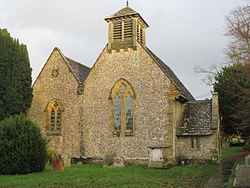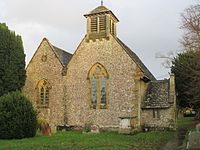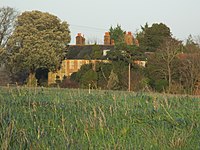Albourne
| Albourne | |
| Sussex | |
|---|---|
 Church of St. Bartholomew | |
| Location | |
| Grid reference: | TQ264166 |
| Location: | 50°56’6"N, 0°12’7"W |
| Data | |
| Population: | 644 (2011) |
| Post town: | Hassocks |
| Postcode: | BN6 |
| Dialling code: | 01273 |
| Local Government | |
| Council: | Mid Sussex |
| Parliamentary constituency: |
Mid Sussex |
Albourne is a village in Sussex, sitting just off the A23 road three miles east of Henfield.
The wider parish has an area of 1,909 acres: the 2011 census recorded 644 people here.
The name comes from an alder-lined stream, which is likely to have been the Cutler's Brook.[1]
During Second World War a bomb fell in the village and did blast damage to the local school. The parish council appealed to raise £200 for immediate repairs to the school and £600 for future repairs. The bomb also damaged the Rectory of the Church and left it without electric lighting or a functioning bath.[2]
Church

The village has a tiny church, St Bartholomew, and grand rectory. The church is of the 12th century, but was largely rebuilt in 1859 with the addition of a north aisle. Parts of the chancel still date back to Saxon and Norman times.
The church is built well away from the village and the noisy A23 down a narrow lane by the park of Albourne Place.[3]
Albourne Place

Albourne Place, in Truslers Hill Lane, stands where there has been a hamlet since before the Domesday Book. It was largely rebuilt in the mid-17th century but it was formerly a manor house.[4] Old Threel House, a Grade II* listed building, is the original part of the 15th Century Albourne House.
It is thought that the murder of Archbishop of Canterbury Thomas Becket in 1170 could have been plotted here by Ranulph and Robert de Broc in answer to Henry II's wishes. In contrast, it is thought to have also played a part in saving the life of a later Archbishop of Canterbury, William Juxon, a supporter of King Charles I, who is believed to have hidden from Cromwell's army by posing as a bricklayer at Albourne.[5]
Albourne Place sits on 9.7-acre grounds and has a working 70-foot well which is fed by an underground stream and is one of the deepest in Sussex. It has passed through a succession of owners including Colonel Sir John Fagg, MP for Rye; Sir Eric Geddes, MP for Cambridge and Charles Goring, MP for Shoreham in the mid-19th Century.
About the village
The village has a golf course, a riding school and a country club.
A number of old and historic buildings dot the village. Albourne Street has a series of very fine old houses, often timber framed, at its south end, such as Gallops (an old timber building, and the oldest building in the village), and The Pound, which was used to impound straying animals. Both buildings were built in the 17th century. In the heart of the village is Woodbine Cottage, childhood home of James Starley, the pioneer of the different gear used on early bicycles, whose success brought prosperity of Coventry.
Church Lane runs west out of Albourne, down past some veteran oak trees, past the old school, over the stream to St Bartholomew's. In the crook of the Lane, to its south the Cutler's Brook meets two other streams.
Cutler's Brook

The Cutler's Brook is a tributary of the River Adur that rises near Clayton. It passes through Hurstpierpoint, south of Albourne and north of Henfield, joining the Adur at Betley Bridge. It is an alder-lined stream that was originally called he 'Alor (Alder) burna (bourne)' and gave the parish its name.[6]
Shaves Wood

Shaves Wood (TQ255145) is an ancient woodland to the south of the parish on the border of the Poynings parish. Many conifer trees have been planted in place of the ancient trees that have been felled. Nevertheless, the Wood has at least 23 indicator species of an ancient woodland and the ground bora survives well in many areas.
The Roman trunk road now called the Sussex Greensand Way, links all the fertile scarp foot farmlands from Pulborough to Barcombe, and was engineered to a high its 'agger' (raised camber) are still visible in Shaves Wood.
The Wood once was home to many butterflies that are now gone. The Duke of Burgundy fritillary is gone from all the Weald, disappearing from its Shipley and Itchingfield sites in the 1970s, to be finally extirpated at Shaves Wood in 1985. The Small pearl-bordered fritillary, now being successfully reintroduced in Sussex, was extinct in West Sussex by 1997, and was last seen in Shave's Wood in 1983. The High Brown Fritillary, which went extinct in West Sussex in 1986 and East Sussex in 1987, was lost from Shaves Wood in the early 1950s and the Marsh Fritillary, which needs damp archaic pastures with Devil's Bit, was lost earlier still in East Sussex in 1946 and West Sussex in 1975. The rough ground next to Shaves Wood was once famous for it, but the last sighting was in 1885.
Holmbush Wood
Holmbush Wood (TQ247143) to the west of Shaves Wood has been incorrectly named on the ordnance survey maps as a plantation. It was not a plantation and has many ancient woodland plants. It retains its old coppice with standards structure of hazel under oak and ash, with a stream flowing through it. There is a population of the scarce and fairy-like Giant Lacewing there.
East Wood
To north of Holmbush Wood is East Wood (TQ249151) which is an old hornbeam coppice. A small 'farm' and a 'Country Club, Hotel and Spa' have been built in it.
Outside links
| ("Wikimedia Commons" has material about Albourne) |
References
- ↑ Mawer, A.; Stenton, F.M.; with Gover, J. E. B.: 'Place-Names of Sussex , Part' (English Place-Names Society, 1929/30)
- ↑ Sussex Notes and Queries, Vol. 10, Number 1, February 1944, p. 19
- ↑ A History of the County of Sussex - Volume 6 pp 130-131: Albourne: Church (Victoria County History)
- ↑ Albourne Place
- ↑ "House where murder plot was hatched" (in en). https://www.theargus.co.uk/news/6764900.house-where-murder-plot-was-hatched/.
- ↑ Mawer, A.; Stenton, F.M.; with Gover, J. E. B.: 'Place-Names of Sussex , Part' (English Place-Names Society, 1929/30)
